MERCEDES-BENZ SL ROADSTER 2008 Service Manual
Manufacturer: MERCEDES-BENZ, Model Year: 2008, Model line: SL ROADSTER, Model: MERCEDES-BENZ SL ROADSTER 2008Pages: 317, PDF Size: 5.35 MB
Page 41 of 317

38230_AKB; 5; 4, en-GB
bjanott
,V ersion: 2.9.6
2008-04-08T15:09:54+02:00
-Seite 38 Dateiname: 6515_3089_02_buchblock.pdf; preflight
Page 42 of 317
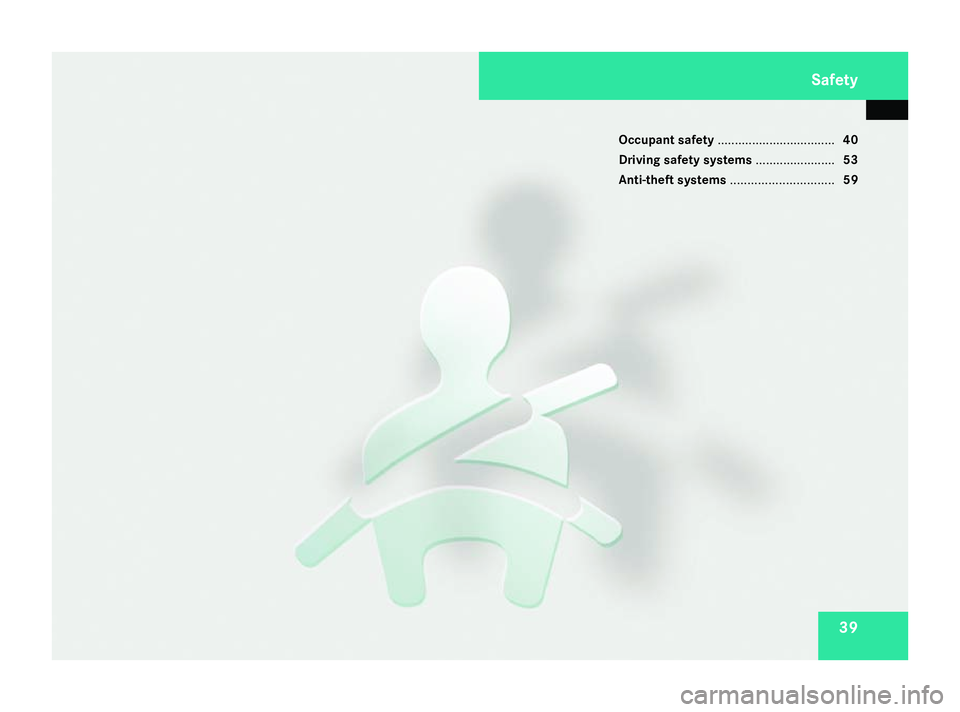
39
Occupant safety
.................................. 40
Driving safet ysystems ....................... 53
Anti-theft systems .............................. 59
Safety
230_AKB
;5;4,en-GB
bjanott, Version:2.9.6
2008-04-08T15:09:54+02:0
0-Seite 39 Dateiname: 6515_3089_02_buchblock.pdf; preflight
Page 43 of 317
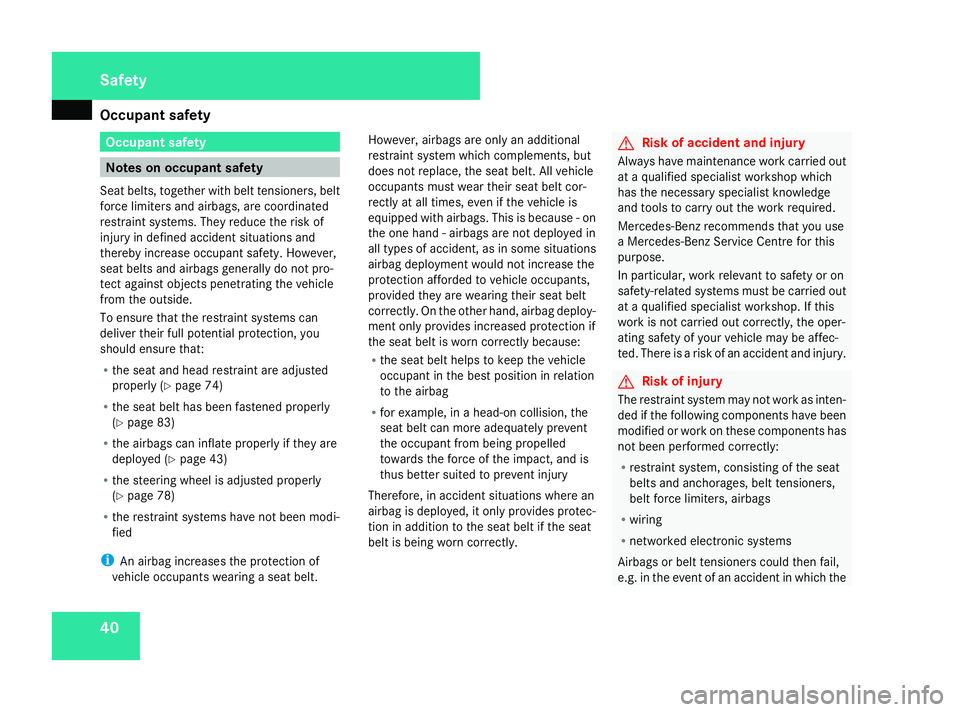
Occupant safety
40 Occupant safety
Notes on occupant safety
Seat belts, together with belt tensioners ,belt
forc elimiters and airbags, are coordinated
restraint systems .They reduce the risk of
injury in defined acciden tsituation sand
thereby increase occupant safety. However,
seat belts and airbags generally do not pro-
tec tagainst objects penetratin gthe vehicle
from the outside.
To ensure that the restraint systems can
deliver their full potential protection ,you
should ensure that:
R the seat and head restraint are adjusted
properly (Y page 74)
R the seat belt has been fastened properly
(Y page 83)
R the airbags can inflat eproperly if they are
deployed (Y page 43)
R the steering wheel is adjusted properly
(Y page 78)
R the restraint systems have not been modi-
fied
i An airbag increases the protection of
vehicle occupants wearing aseat belt. However, airbags are only an additional
restraint system which complements, but
does not replace, the seat belt. All vehicle
occupants must wear their seat belt cor-
rectly at all times, even if the vehicle is
equipped with airbags. This is because
-on
the one hand -airbags are not deployed in
all types of accident, as in some situations
airbag deployment would not increase the
protection afforded to vehicle occupants,
provided they are wearing their seat belt
correctly. On the other hand, airbag deploy-
ment only provides increased protection if
the seat belt is worn correctly because:
R the seat belt helps to keep the vehicle
occupant in the best position in relation
to the airbag
R for example, in ahead-on collision, the
seat belt can more adequately prevent
the occupant from being propelled
towards the forc eofthe impact ,and is
thus better suited to preven tinjury
Therefore, in acciden tsituation swhere an
airbag is deployed, it only provides protec-
tion in addition to the seat belt if the seat
belt is being worn correctly. G
Risk of accident and injury
Always have maintenanc ework carried out
at aq ualified specialist workshop which
has the necessary specialist knowledge
and tools to carry out the work required.
Mercedes-Benz recommends that you use
aM ercedes-Benz Service Centr efor this
purpose.
In particular, work relevant to safety or on
safety-related systems must be carried out
at aq ualified specialist workshop. If this
work is not carried out correctly, the oper-
ating safety of your vehicle may be affec-
ted. There is arisk of an acciden tand injury. G
Risk of injury
The restraint system may not work as inten-
ded if the following component shave been
modified or work on these component shas
not been performed correctly:
R restraint system, consistin gofthe seat
belts and anchorages, belt tensioners,
belt forc elimiters ,airbags
R wiring
R networked electronic systems
Airbags or belt tensioners could then fail,
e.g. in the event of an acciden tinwhich the Safety
230_AKB
;5;4,en-GB
bjanott, Version:2.9.6
2008-04-08T15:09:54+02:0
0-Seite 40 Dateiname: 6515_3089_02_buchblock.pdf; preflight
Page 44 of 317
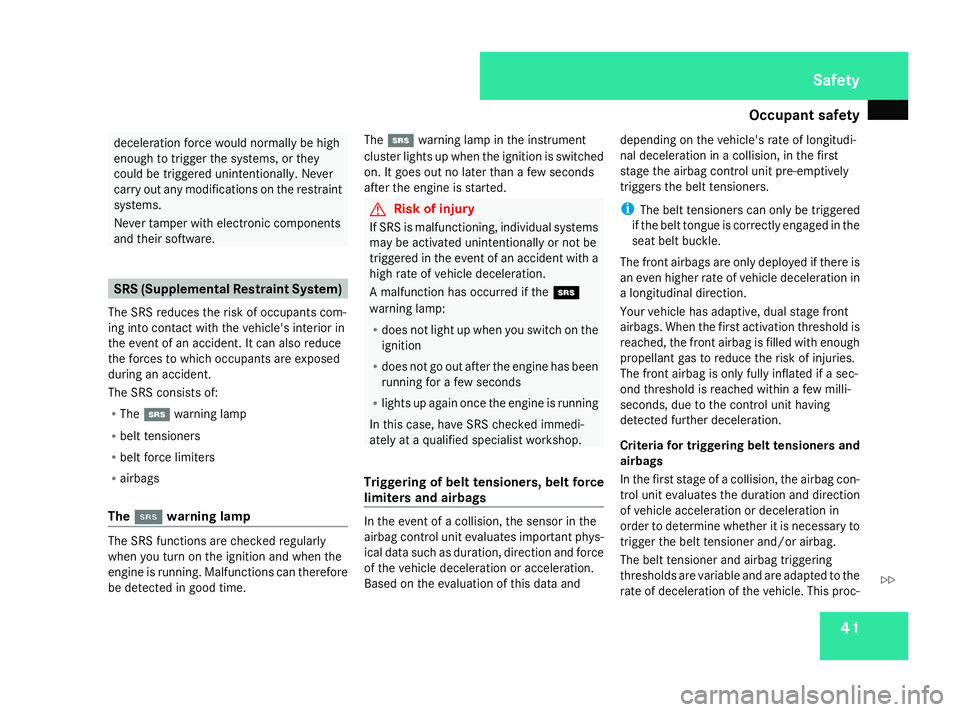
Occupant safety
41deceleration forc
ewould normally be high
enough to trigger the systems ,orthey
could be triggered unintentionally. Never
carry out any modifications on the restraint
systems.
Never tamper with electronic components
and their software. SRS (Supplementa
lRestraint System)
The SRS reduces the risk of occupants com-
ing int ocontact with the vehicle's interior in
the event of an accident. It can also reduce
the forces to which occupants are exposed
during an accident.
The SRS consists of:
R The 1 warning lamp
R belt tensioners
R belt forc elimiters
R airbags
The 1 1 warning lamp The SRS function
sare checked regularly
when you turn on the ignition and when the
engin eisrunning. Malfunctions can therefore
be detected in good time. The
1 warning lamp in the instrument
cluster lights up when the ignition is switched
on. It goes out no later than afew seconds
after the engin eisstarted. G
Risk of injury
If SRS is malfunctioning, individual systems
may be activated unintentionally or not be
triggered in the event of an acciden twith a
high rate of vehicle deceleration.
Am alfunction has occurred if the 1
warning lamp:
R does not light up when you switch on the
ignition
R does not go out after the engin ehas been
running for afew seconds
R lights up again onc ethe engin eisrunning
In this case, have SRS checked immedi-
ately at aqualified specialist workshop.
Triggering of belt tensioners, belt force
limiter sand airbags In the event of
acollision, the sensor in the
airbag control unit evaluates important phys-
ical data such as duration, direction and force
of the vehicle deceleration or acceleration.
Based on the evaluation of this data and depending on the vehicle's rate of longitudi-
nal deceleration in
acollision, in the first
stage the airbag control unit pre-emptively
trigger sthe belt tensioners.
i The belt tensioners can only be triggered
if the belt tongue is correctly engaged in the
seat belt buckle.
The fron tairbags are only deployed if ther eis
an even higher rate of vehicle deceleration in
al ongitudinal direction.
Your vehicle has adaptive, dual stage front
airbags. When the first activation threshold is
reached, the fron tairbag is filled with enough
propellant gas to reduce the risk of injuries.
The fron tairbag is only fully inflated if asec-
ond threshold is reached within afew milli-
seconds, due to the control unit having
detected further deceleration.
Criteria for triggering belt tensioners and
airbags
In the first stage of acollision, the airbag con-
trol unit evaluates the duration and direction
of vehicle acceleration or deceleration in
order to determine whether it is necessary to
trigger the belt tensioner and/or airbag.
The belt tensioner and airbag triggering
thresholds are variable and are adapted to the
rate of deceleration of the vehicle. This proc- Safety
230_AKB
;5;4,en-GB
bjanott, Version:2.9.6
2008-04-08T15:09:54+02:0
0-Seite 41 ZDateiname: 6515_3089_02_buchblock.pdf; preflight
Page 45 of 317
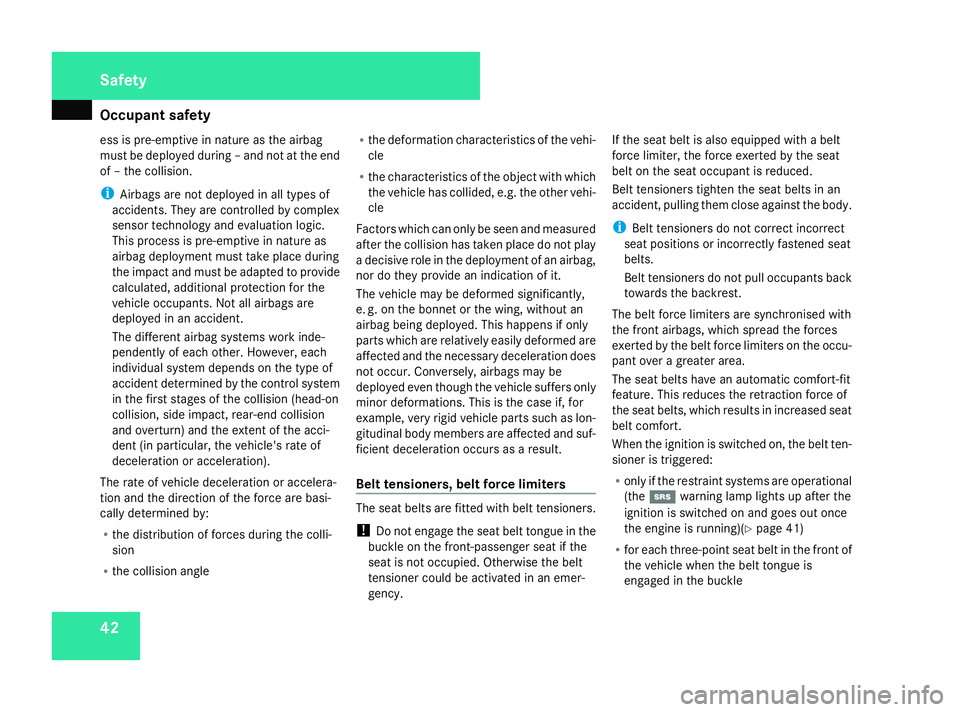
Occupant safety
42
ess is pre-emptive in nature as the airbag
must be deployed during –and not at the end
of –t he collision.
i Airbags are not deployed in all types of
accidents. They are controlled by complex
sensor technology and evaluation logic.
This proces sispre-emptive in nature as
airbag deployment must take place during
the impact and must be adapted to provide
calculated, additional protection for the
vehicle occupants. Not all airbags are
deployed in an accident.
The differen tairbag systems work inde-
pendently of each other .However, each
individual system depends on the type of
acciden tdetermined by the control system
in the first stages of the collision (head-on
collision, side impact ,rear-en dcollision
and overturn) and the extent of the acci-
dent (in particular, the vehicle's rate of
deceleration or acceleration).
The rate of vehicle deceleration or accelera-
tion and the direction of the forc eare basi-
cally determined by:
R the distribution of forces during the colli-
sion
R the collision angle R
the deformation characteristic softhe vehi-
cle
R the characteristic softhe objec twith which
the vehicle has collided, e.g. the other vehi-
cle
Factors which can only be seen and measured
after the collision has taken place do not play
ad ecisive role in the deployment of an airbag,
nor do they provide an indication of it.
The vehicle may be deformed significantly,
e. g. on the bonnet or the wing, without an
airbag being deployed. This happens if only
parts which are relatively easily deformed are
affected and the necessary deceleration does
not occur. Conversely, airbags may be
deployed even though the vehicle suffers only
minor deformations .This is the case if, for
example, very rigid vehicle parts such as lon-
gitudinal body members are affected and suf-
ficien tdeceleration occurs as aresult.
Belt tensioners, belt force limiters The seat belts are fitted with belt tensioners.
!
Do not engage the seat belt tongue in the
buckle on the front-passenger seat if the
seat is not occupied. Otherwise the belt
tensioner could be activated in an emer-
gency. If the seat belt is also equipped with
abelt
forc elimiter, the forc eexerted by the seat
belt on the seat occupant is reduced.
Belt tensioners tighten the seat belts in an
accident, pulling them close against the body.
i Belt tensioners do not correct incorrect
seat position sorincorrectly fastened seat
belts.
Belt tensioners do not pull occupants back
towards the backrest.
The belt forc elimiters are synchronised with
the fron tairbags, which spread the forces
exerted by the belt forc elimiters on the occu-
pant over agreater area.
The seat belts have an automatic comfort-fit
feature. This reduces the retraction forc eof
the seat belts, which results in increased seat
belt comfort.
When the ignition is switched on, the belt ten-
sioner is triggered:
R only if the restraint systems are operational
(the 1 warning lamp lights up after the
ignition is switched on and goes out once
the engin eisrunning)(Y page 41)
R for each three-poin tseat belt in the fron tof
the vehicle when the belt tongue is
engaged in the buckle Safety
230_AKB
;5;4,en-GB
bjanott, Version:2.9.6
2008-04-08T15:09:54+02:0
0-Seite 42 Dateiname: 6515_3089_02_buchblock.pdf; preflight
Page 46 of 317
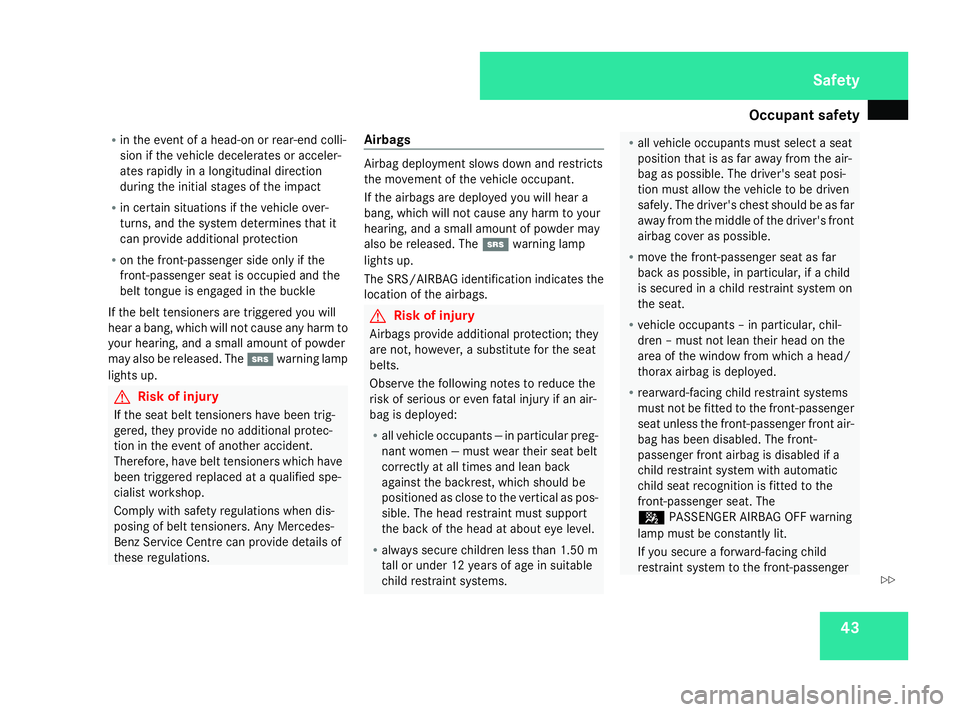
Occupant safety
43
R
in the event of ahead-on or rear-en dcolli-
sion if the vehicle decelerates or acceler-
ates rapidly in alongitudinal direction
during the initial stages of the impact
R in certain situation sifthe vehicle over-
turns, and the system determines that it
can provide additional protection
R on the front-passenger side only if the
front-passenger seat is occupied and the
belt tongue is engaged in the buckle
If the belt tensioners are triggered you will
hear abang, which will not cause any harm to
your hearing, and asmall amount of powder
may also be released. The 1warning lamp
lights up. G
Risk of injury
If the seat belt tensioners have been trig-
gered, they provide no additional protec-
tion in the event of another accident.
Therefore, have belt tensioners which have
been triggered replaced at aqualified spe-
cialist workshop.
Comply with safety regulations when dis-
posing of belt tensioners .Any Mercedes-
Ben zService Centr ecan provide details of
these regulations. Airbags Airbag deployment slows down and restricts
the movement of the vehicle occupant.
If the airbags are deployed you will hear a
bang, which will not cause any harm to your
hearing, and
asmall amount of powder may
also be released. The 1warning lamp
lights up.
The SRS/AIRBAG identification indicates the
location of the airbags. G
Risk of injury
Airbags provide additional protection ;they
are not ,however, asubstitute for the seat
belts.
Observe the following notes to reduce the
risk of serious or even fatal injury if an air-
bag is deployed:
R all vehicle occupants —inparticular preg-
nant women —must wear their seat belt
correctly at all times and lean back
against the backrest, which should be
positioned as close to the vertical as pos-
sible. The head restraint must support
the back of the head at about eye level.
R alway ssecure children less than 1.5 0m
tall or under 12 years of age in suitable
child restraint systems. R
all vehicle occupants must select aseat
position that is as far away from the air-
bag as possible. The driver's seat posi-
tion must allow the vehicle to be driven
safely. The driver's chest should be as far
away from the middle of the driver's front
airbag cover as possible.
R move the front-passenger seat as far
back as possible, in particular, if achild
is secured in achild restraint system on
the seat.
R vehicle occupants –inparticular, chil-
dren –must not lean their head on the
area of the window from which ahead/
thorax airbag is deployed.
R rearward-facing child restraint systems
must not be fitted to the front-passenger
seat unless the front-passenger fron tair-
bag has been disabled. The front-
passenger fron tairbag is disabled if a
child restraint system with automatic
child seat recognition is fitted to the
front-passenger seat. The
5 PASSENGER AIRBAG OFF warning
lamp must be constantly lit.
If you secure aforward-facin gchild
restraint system to the front-passenger Safety
230_AKB
;5;4,en-GB
bjanott, Version:2.9.6
2008-04-08T15:09:54+02:0
0-Seite 43 ZDateiname: 6515_3089_02_buchblock.pdf; preflight
Page 47 of 317
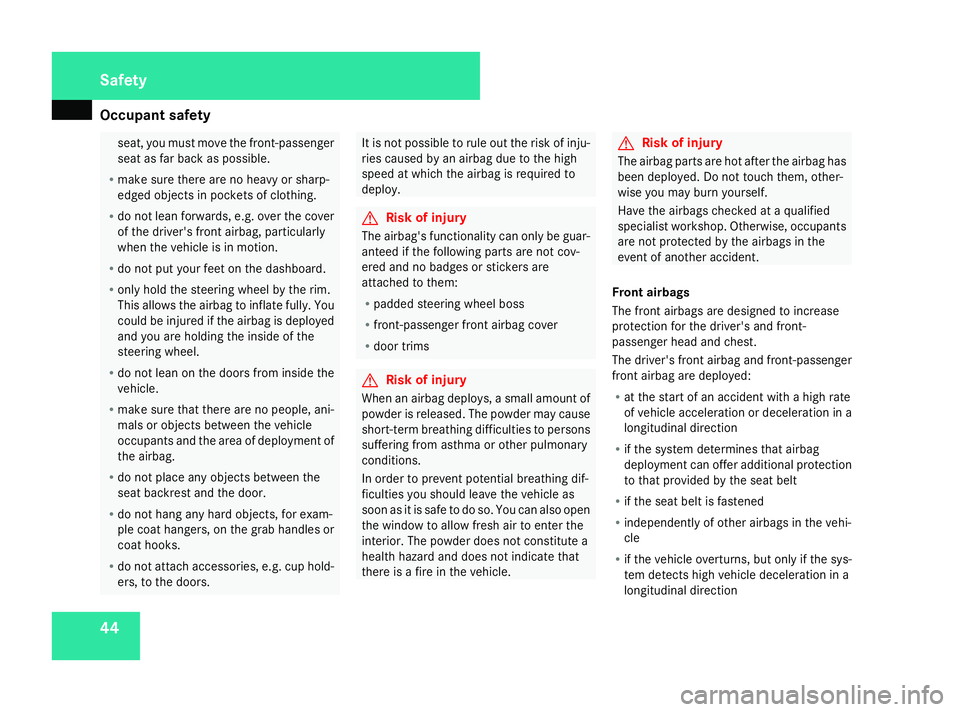
Occupant safety
44 seat, you must move the front-passenger
seat as far back as possible.
R make sure ther eare no heavy or sharp-
edged objects in pockets of clothing.
R do not lean forwards, e.g. over the cover
of the driver's fron tairbag, particularly
when the vehicle is in motion.
R do not put your feet on the dashboard.
R only hold the steering wheel by the rim.
This allows the airbag to inflat efully. You
could be injured if the airbag is deployed
and you are holding the inside of the
steering wheel.
R do not lean on the doors from inside the
vehicle.
R make sure that ther eare no people, ani-
mals or objects between the vehicle
occupants and the area of deployment of
the airbag.
R do not place any objects between the
seat backrest and the door.
R do not hang any hard objects, for exam-
ple coat hangers, on the grab handles or
coat hooks.
R do not attach accessories, e.g. cup hold-
ers, to the doors. It is not possible to rule out the risk of inju-
ries caused by an airbag due to the high
speed at which the airbag is required to
deploy. G
Risk of injury
The airbag's functionality can only be guar-
anteed if the following parts are not cov-
ered and no badges or stickers are
attached to them:
R padded steering wheel boss
R front-passenger fron tairbag cover
R door trims G
Risk of injury
When an airbag deploys, asmall amount of
powder is released. The powder may cause
short-term breathin gdifficulties to persons
sufferin gfrom asthma or other pulmonary
conditions.
In order to preven tpotential breathin gdif-
ficulties you should leave the vehicle as
soon as it is safe to do so. You can also open
the window to allow fresh air to enter the
interior. The powder does not constitute a
health hazard and does not indicat ethat
ther eisaf ire in the vehicle. G
Risk of injury
The airbag parts are hot after the airbag has
been deployed. Do not touch them ,other-
wise you may burn yourself.
Have the airbags checked at aqualified
specialist workshop. Otherwise, occupants
are not protected by the airbags in the
event of another accident.
Front airbags
The fron tairbags are designed to increase
protection for the driver's and front-
passenger head and chest.
The driver's fron tairbag and front-passenger
fron tairbag are deployed:
R at the start of an acciden twith ahigh rate
of vehicle acceleration or deceleration in a
longitudinal direction
R if the system determines that airbag
deployment can offer additional protection
to that provided by the seat belt
R if the seat belt is fastened
R independently of other airbags in the vehi-
cle
R if the vehicle overturns, but only if the sys-
tem detects high vehicle deceleration in a
longitudinal direction Safety
230_AKB
;5;4,en-GB
bjanott, Version:2.9.6
2008-04-08T15:09:54+02:0
0-Seite 44 Dateiname: 6515_3089_02_buchblock.pdf; preflight
Page 48 of 317

Occupant safety
451
Driver's front airbag
2 Front-passenger front airbag
Driver's front airbag 1deploysinf ront of the
steering wheel; front-passenger front airbag
2 deploysinf ront of and above the glove
compartment.
Front-passenger front airbag 2is only
deployed if the front-passenger seat is occu-
pied or if the 5PASSENGER AIRBAG OFF
warning lamp in the centre console is not lit.
(Y page 49) This means that achild restraint
system with automatic child seat recogni-
tion* has not been fitted to the front-
passenger seat or has been fitted incorrectly.
! Do not place heavy objectsont he front-
passenger seat. The system might errone-
ously interpret this as aperson occupying the seat and the restraint systems on the
front-passenger seat may then be triggered
in the event of an accident and would have
to be replaced.
Head/thoraxa irbags
Head/thorax airbags are intended to offer
additional protection for the head and thorax
when deployed. However, they do not protect
the arms. 1
Head/thorax airbag
Head/thorax airbags 1inflate in the door
area. Head/thorax airbags
1are deployed:
R on the side on which an impact occurs
R at the start of an accident with ahigh rate
of lateral vehicle deceleration or accelera-
tion, e.g. in aside impact
R if the system determines that airbag
deployment can offer additional protection
to that provided by the seat belt
R if the seat belt is fastened
R independently of the front airbags
R independently of the belt tensioners
R on the front-passenger side only if the
front-passenger seat occupancy recogni-
tion system detectst hat the front-
passenger seat is occupied Safety
*o ptional
230_AKB; 5; 4, en-GB
bjanott
,V ersion: 2.9.6
2008-04-08T15:09:54+02:00
-Seite 45 ZDateiname: 6515_3089_02_buchblock.pdf; preflight
Page 49 of 317
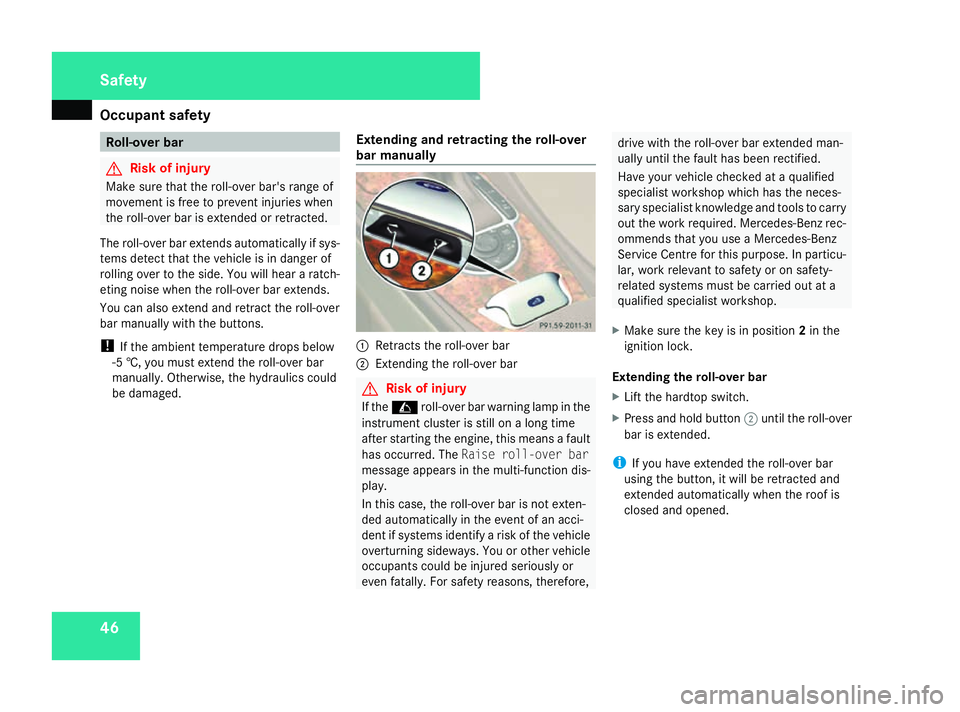
Occupant safety
46 Roll-over bar
G
Risk of injury
Make sure that the roll-over bar's range of
movemen tisfree to preven tinjuries when
the roll-over bar is extended or retracted.
The roll-over bar extends automatically if sys-
tems detec tthat the vehicle is in danger of
rolling over to the side. You will hear aratch-
etin gnoise when the roll-over bar extends.
You can also extend and retract the roll-over
bar manually with the buttons.
! If the ambient temperature drops below
-5 †, you must extend the roll-over bar
manually. Otherwise, the hydraulics could
be damaged. Extending and retracting the roll-over
bar manually 1
Retract sthe roll-over bar
2 Extending the roll-over bar G
Risk of injury
If the C roll-over bar warning lamp in the
instrument cluster is still on along time
after starting the engine, this means afault
has occurred. The Raise roll-over bar
message appears in the multi-function dis-
play.
In this case, the roll-over bar is not exten-
ded automatically in the event of an acci-
dent if systems identify arisk of the vehicle
overturnin gsideways. You or other vehicle
occupants could be injured seriously or
even fatally. For safety reasons ,therefore, drive with the roll-over bar extended man-
ually until the fault has been rectified.
Have your vehicle checked at
aqualified
specialist workshop which has the neces-
sary specialist knowledge and tools to carry
out the work required. Mercedes-Benz rec-
ommends that you use aMercedes-Benz
Service Centr efor this purpose. In particu-
lar, work relevant to safety or on safety-
related systems must be carried out at a
qualified specialist workshop.
X Make sure the key is in position 2in the
ignition lock.
Extending the roll-over bar
X Lift the hardtop switch.
X Press and hold button 2until the roll-over
bar is extended.
i If you have extended the roll-over bar
using the button, it will be retracted and
extended automatically when the roof is
closed and opened. Safety
230_AKB
;5;4,en-GB
bjanott, Version:2.9.6
2008-04-08T15:09:54+02:0
0-Seite 46 Dateiname: 6515_3089_02_buchblock.pdf; preflight
Page 50 of 317
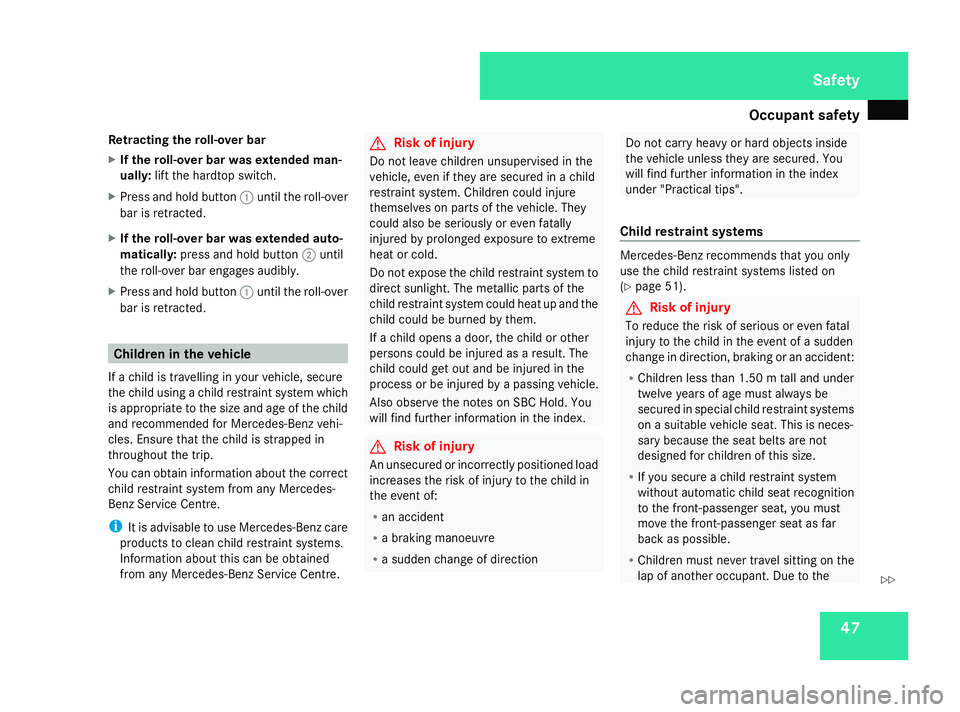
Occupant safety
47
Retracting the roll-over bar
X
If the roll-over bar was extended man-
ually: lift the hardtop switch.
X Press and hold button 1until the roll-over
bar is retracted.
X If the roll-over bar was extended auto-
matically: press and hold button 2until
the roll-over bar engages audibly.
X Press and hold button 1until the roll-over
bar is retracted. Children in the vehicle
If ac hild is travelling in your vehicle, secure
the child using achild restraint system which
is appropriate to the size and age of the child
and recommended for Mercedes-Benz vehi-
cles. Ensure that the child is strapped in
throughout the trip.
You can obtain information about the correct
child restraint system from any Mercedes-
Ben zService Centre.
i It is advisable to use Mercedes-Benz care
product stoclean child restraint systems.
Information about this can be obtained
from any Mercedes-Benz Service Centre. G
Risk of injury
Do not leave children unsupervised in the
vehicle, even if they are secured in achild
restraint system. Children could injure
themselves on parts of the vehicle. They
could also be seriously or even fatally
injured by prolonged exposure to extreme
heat or cold.
Do not expose the child restraint system to
direct sunlight .The metallic parts of the
child restraint system could heat up and the
child could be burned by them.
If ac hild opens adoor, the child or other
person scould be injured as aresult. The
child could get out and be injured in the
proces sorbei njured by apassing vehicle.
Also observe the notes on SBC Hold. You
will find further information in the index. G
Risk of injury
An unsecured or incorrectly positioned load
increases the risk of injury to the child in
the event of:
R an accident
R ab rakin gmanoeuvre
R as udden chang eofdirection Do not carry heavy or hard objects inside
the vehicle unless they are secured. You
will find further information in the index
under "Practical tips".
Child restraint systems Mercedes-Benz recommends that you only
use the child restraint systems listed on
(Y
page 51). G
Risk of injury
To reduce the risk of serious or even fatal
injury to the child in the event of asudden
chang eindirection, brakin goranaccident:
R Children less than 1.5 0mtall and under
twelve years of age must alway sbe
secured in special child restraint systems
on asuitable vehicle seat. This is neces-
sary because the seat belts are not
designed for children of this size.
R If you secure achild restraint system
without automatic child seat recognition
to the front-passenger seat, you must
move the front-passenger seat as far
back as possible.
R Children must never travel sitting on the
lap of another occupant. Due to the Safety
230_AKB
;5;4,en-GB
bjanott, Version:2.9.6
2008-04-08T15:09:54+02:0
0-Seite 47 ZDateiname: 6515_3089_02_buchblock.pdf; preflight